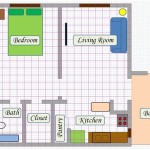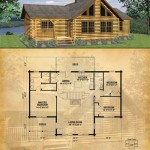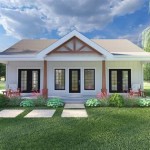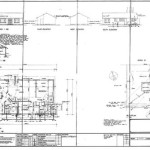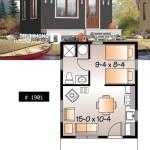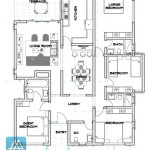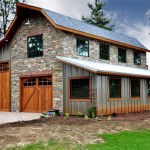Exploring the Appeal of 1-Story Craftsman Style House Plans
The Craftsman architectural style, a movement that originated in the late 19th and early 20th centuries, remains a highly sought-after aesthetic in residential design. Characterized by its emphasis on natural materials, handcrafted elements, and functional design, the Craftsman style offers a timeless appeal that continues to resonate with homeowners. Single-story Craftsman house plans are particularly popular, combining the inherent charm of the style with the accessibility and convenience of single-level living. This article will delve into the defining features, benefits, and considerations associated with 1-story Craftsman style house plans.
Craftsman architecture emerged as a reaction against the ornate and mass-produced designs of the Victorian era. It championed simplicity, honesty in construction, and a connection to nature. This philosophy translated into homes that prioritized quality craftsmanship, often featuring exposed structural elements and locally sourced materials. The popularity of the style was further cemented by publications like "The Craftsman" magazine, edited by Gustav Stickley, which promoted the ideals of the movement and provided plans for affordable and well-designed homes.
Today, the Craftsman style endures as a symbol of enduring quality and comfortable living. Modern interpretations of the style often incorporate contemporary amenities and sustainable building practices while retaining the core aesthetic principles that define it. This adaptability makes 1-story Craftsman house plans a versatile choice for a wide range of homeowners, from those seeking a cozy retirement retreat to families looking for a practical and aesthetically pleasing home.
Defining Characteristics of 1-Story Craftsman House Plans
Several key elements contribute to the distinctive look of a 1-story Craftsman style home. These features, often combined in varying degrees, create the characteristic warmth and charm associated with this architectural style. Understanding these elements is crucial for appreciating the design principles and selecting a plan that aligns with individual preferences.
One of the most recognizable features is the low-pitched roof, typically with wide overhanging eaves. These eaves provide shade and protection from the elements, contributing to the home's energy efficiency. Often, the roof will incorporate exposed rafter tails, which are the ends of the roof rafters that extend beyond the wall. This detail adds a visual interest and emphasizes the handcrafted nature of the design. Dormers, which are roof projections with windows, may also be included to provide additional light and ventilation to the attic space.
Porches are integral to the Craftsman style, often extending across the front of the house and providing a welcoming outdoor space. These porches are typically supported by substantial columns, which may be tapered or feature stone or brick piers. The presence of a porch emphasizes the connection between the indoor and outdoor spaces, encouraging relaxation and social interaction. In some designs, the porch may wrap around the side of the house, creating a more expansive outdoor living area.
Natural materials are a cornerstone of Craftsman design. Wood, stone, and brick are commonly used for both the exterior and interior of the home. Wood siding, often in the form of clapboard or shingles, is a popular choice for the exterior walls. Stone or brick may be used for accents, such as foundation walls, porch columns, or chimneys. Inside, wood is often used for trim, flooring, and cabinetry, creating a warm and inviting atmosphere. The use of natural materials connects the home to its surroundings and contributes to its overall sense of authenticity.
Windows in Craftsman homes are often multi-paned, with a grid pattern in the upper sash. Double-hung windows are common, allowing for efficient ventilation. Casement windows, which swing outward, may also be used. The windows are typically surrounded by substantial wood trim, which adds to the visual interest of the facade. The placement and size of the windows are carefully considered to maximize natural light and provide views of the surrounding landscape.
Interior details in Craftsman homes often reflect the same emphasis on natural materials and handcrafted elements. Exposed beams, built-in cabinetry, and handcrafted fireplace surrounds are common features. The use of warm, earthy colors further enhances the cozy and inviting atmosphere. Open floor plans are also frequently incorporated, creating a sense of spaciousness and facilitating interaction between family members. The interior design reflects the same principles of simplicity, functionality, and connection to nature that define the exterior of the home.
Advantages of Choosing a 1-Story Craftsman House Plan
Opting for a 1-story Craftsman house plan presents several distinct advantages, catering to a variety of lifestyle needs and preferences. These benefits extend beyond the aesthetic appeal, offering practical considerations for accessibility, maintenance, and overall livability.
Accessibility is a primary benefit of single-story living. With no stairs to navigate, a 1-story home is ideal for individuals with mobility limitations, including seniors and those with disabilities. This eliminates the risk of falls and promotes independent living. Furthermore, a single-story layout allows for easier aging in place, enabling homeowners to remain in their homes comfortably and safely as they age.
Maintenance is often simplified in a 1-story home. With all living spaces on a single level, tasks such as cleaning, painting, and roof repairs are generally more accessible and manageable. There is no need to carry equipment or materials up and down stairs, reducing the physical strain associated with home maintenance. This can translate to lower maintenance costs and a more convenient lifestyle.
Energy efficiency can be enhanced in a well-designed 1-story home. With less surface area exposed to the elements, heat loss and gain can be minimized. Proper insulation, efficient windows, and a well-sealed building envelope can further contribute to reduced energy consumption. Additionally, the low-pitched roof of a Craftsman home is often well-suited for solar panel installation, providing an opportunity to generate renewable energy and further reduce energy costs.
Flexibility in design is another advantage of 1-story Craftsman house plans. The layout can be easily adapted to accommodate changing needs and lifestyles. For example, rooms can be repurposed as home offices, guest rooms, or hobby spaces. The open floor plans often found in Craftsman homes provide opportunities for creating flexible and multi-functional living areas. Furthermore, modifications can be made more easily without the complexities associated with multi-story structures.
A connection to the outdoors is often emphasized in 1-story Craftsman homes. The presence of a porch encourages outdoor living and provides a transition between the indoor and outdoor spaces. Large windows and sliding glass doors can further enhance the connection to the surrounding landscape. This promotes a sense of well-being and provides opportunities for enjoying the natural environment.
Considerations When Selecting a 1-Story Craftsman House Plan
While 1-story Craftsman house plans offer numerous advantages, careful consideration should be given to several factors before making a final decision. These considerations relate to lot size, privacy, and the potential for future expansion.
Lot size is a crucial factor, as 1-story homes typically require a larger footprint than multi-story homes with the same square footage. A larger lot allows for a more spacious layout and provides ample outdoor space. It is important to ensure that the selected plan fits comfortably on the lot while complying with zoning regulations and setback requirements. Careful site planning is essential to maximize the use of the available space and to ensure proper orientation for sunlight and ventilation.
Privacy can be a concern in 1-story homes, particularly in densely populated areas. With all living spaces on a single level, there may be less separation from neighboring properties. Careful landscaping, fencing, and window placement can help to mitigate this issue and create a greater sense of privacy. The orientation of the house on the lot should also be considered to minimize views from adjacent buildings.
Future expansion potential should be considered if there is a possibility of needing more space in the future. While adding a second story to an existing 1-story home can be challenging and costly, it is sometimes feasible. Alternatively, adding an addition to the side or rear of the house may be a more practical solution. When selecting a plan, it is important to consider the possibilities for future expansion and to ensure that the lot can accommodate any potential additions.
Cost considerations are also important. While the initial construction cost of a 1-story home may be lower than that of a multi-story home with the same square footage, other factors can influence the overall cost. The larger footprint of a 1-story home may require more extensive site preparation and foundation work. Additionally, the cost of roofing and exterior finishes may be higher due to the larger surface area. It is important to obtain accurate cost estimates from reputable builders and to factor in all associated expenses when making a decision.
Local climate and building codes should also be taken into account. The design and construction of a 1-story Craftsman home should be adapted to the specific climate conditions of the region. This may involve selecting appropriate materials, incorporating energy-efficient features, and designing for optimal solar orientation. Compliance with local building codes is essential to ensure the safety and structural integrity of the home.
:max_bytes(150000):strip_icc()/SL-1444_FCR-6feba1b011944212b854a6aabde38158.jpg?strip=all)
These One Story Craftsman House Plans Are Full Of Southern Charm

Craftsman Style House Plans Big And Small Houseplans Blog Com

1 Story Craftsman House Plan Foxborough Retirement Plans Farmhouse

1 Story Modern Cottage Style House Plan Spaulding Craftsman Plans Farmhouse

Craftsman Style House Plan 4 Beds 3 Baths 2988 Sq Ft 1079 1 Houseplans Com

4 Bedroom 1 Story Modern Farmhouse Style Plan With Outdoor Living Area And Bonus Room Westchester Craftsman House Plans

Single Story Craftsman Home Plans Blog Eplans Com

Durham Drive Craftsman House Plans Ranch

Craftsman House Plans Style Home The Designers

Plan 034h 0007 The House

